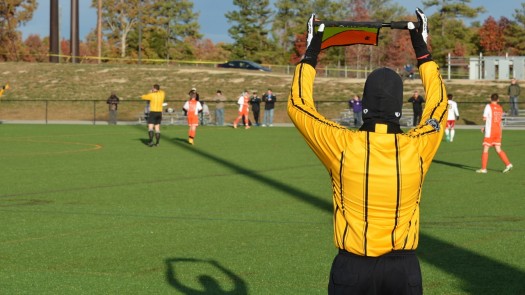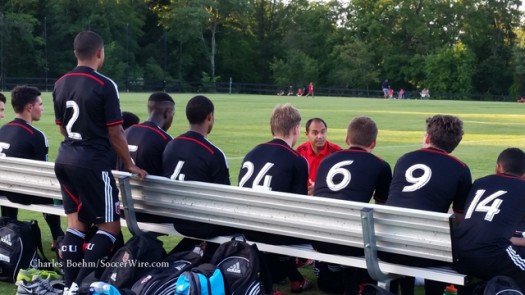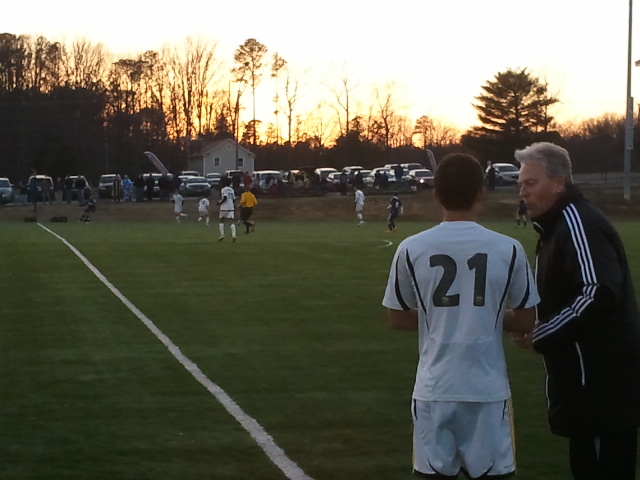Five ways to develop soccer players during a blowout without disrespecting opponents
Have you seen the story about the Southern California high school girls basketball team that won 161-2?
No kidding.
As reported by the San Bernardino County Sun, Arroyo Valley High School Head Coach Michael Anderson was suspended for two games as a result, but defends himself to the Sun’s Pete Marshall with the following explanation:
“I didn’t play any starters in the second half,” and “I didn’t expect them [Bloomington] to be that bad, I’m not trying to embarrass anybody. And I didn’t expect my bench to play that well. I had one [bench] player make eight of nine 3[-pointer]s.”
Anderson also defended himself saying that he tried to get the referees to run the clock non-stop in the second half, but they only agreed to so in the fourth quarter. He also said he restricted his players not to shoot until there were less than seven seconds on the shot clock, and they didn’t “full-court press” in the second half either
All too little too late, really, as the halftime score before all of these moves was 104-1!
We’re a soccer website, not basketball, but this certainly brings up a lot of questions that do get “kicked around” a lot in soccer coaching and parents circles. What do you do when you come up against a comprehensively overmatched team in soccer?
Many feel it’s an insult to the opponent to not play your best, but there has to be a line right? The longer you wait to “call off the dogs” against an inferior opponent, the more risk you run of unnecessarily embarrassing that opponent, which could cause you to do things that then further disrespects them on top of it!
Here are five ways, in order of recommended implementation, to limit the embarrassment without artificially removing competitiveness from a team’s players. Once you know a win is secure, the sooner you begin moving through these, the MORE you’ll help develop players on BOTH teams, and the LESS you’ll risk teaching your players bad habits while simply humiliating your opponents.
1. Bench the starters*
 This really should be the first go-to in any situation as it provides more field time to players further down the bench. It also rests starters who probably need it given the number of games kids play each week and weekend is still way too high.
This really should be the first go-to in any situation as it provides more field time to players further down the bench. It also rests starters who probably need it given the number of games kids play each week and weekend is still way too high.
If you’re lucky, you’ll find you have more depth on your bench than you thought.
But of course that probably means the goals will keep flying in, so what’s next?
2. Change positions
Move attacking players to central defense and holding mids, and even one in goal, because you never know when you’ll need a third-string ‘keeper, and the minutes will help find out who that might be.
You might find out you’ve been playing some in the wrong position all along, and it always helps players understand their own positions better if they can empathize with the other spots.
A great way to develop a forward’s play is to also teach them how defenders are taught to defend forwards!
And few things give more respect for a goalkeeper’s plight than to have your center backs spend some time between the pipes themselves!
The irony is if you’ve been developing your players the proper way all along, this might not slow the scoring either because the best players are already well rounded and already understand the other positions.
And if this doesn’t slow the scoring?
3. Change formations and roles
 Get out of that attacking 4-2-3-1 or 4-3-3 and try a 4-4-2 or 4-5-1 bunker for that time when you might really need to know how! This won’t be so easy if it’s only a label and your players still bomb forward and don’t play their roles. But that’s another test of your coaching and player development abilities right?
Get out of that attacking 4-2-3-1 or 4-3-3 and try a 4-4-2 or 4-5-1 bunker for that time when you might really need to know how! This won’t be so easy if it’s only a label and your players still bomb forward and don’t play their roles. But that’s another test of your coaching and player development abilities right?
If you can’t implement a formation change without needing an extended halftime and 22 disc cones to explain what it is and each players’ new role, then you are too much a game coach and not enough of a developer of players.
Really, the whole idea of “formation” is really better measured in “organization”. Can you walk up to a U-15 game at a college showcase and tell within 30 seconds of play what formation a team is in? It’s pretty easy at the pro level, but without constant organization and clearly defined roles for each player, more often than not the kids get caught up too much in “defenders defend, midfielders swarm the ball, and strikers only need to score.”
EVERY team needs to get better at organization and understanding roles, so if you’e blowing someone out, see if you can work on holding a shape and narrowing each player’s role to just one or two responsibilities. It should reduce pressure on the opponent in their own defensive third, but also make it very hard for that opponent to break through, which preserves the second most important outcome of every competitive game – keeping a clean sheet.
One more adjustment on this subject that should be easy to hide from an inferior opponent but still test your team’s organization in transition is to insert one simple “rule” that isn’t “taking it easy” as much as acting as a mental test and visual trigger that helps develop entire teams in a single move.
Simply instruct the team that unless they’re in on goal directly from a turn over, that once they win the ball, the first pass must go backwards. That should really give them a chance to re-organize from a defensive posture into an attacking one and provide a ton of great coaching points if every player’s reaction isn’t immediate, obvious, and correct.
Too many times in youth soccer it’s full steam ahead all the time, and every player’s reaction when their team wins the ball is to run straight toward the opponents goal as fast as possible. There is little movement to establish immediate support (i.e. passing options) for the first attacker (the one with the ball), and not a lot of clear effort to provide width and depth.
This instantaneously direct approach may work if you greatly out-match the opponent, but against the good teams you’ll pay the price on the scoreboard while missing a great opportunity to prepare players with good habits they’ll need to personally succeed at higher levels for your team to compete against tougher opponents.
Still scoring too easily?
4. Change Tactics
A little bit of this is already found in No. 3, but you can go much deeper here. One of the biggest things practiced at the professional level I RARELY see in the youth, or even college game, is setting a “line of confrontation” and a “defensive height.”
The line of confrontation is similar to the opening basketball analogy of “full-court press,” or not. It might seem obvious, but if you don’t pressure the team in their own half, then you’re less likely to be two, one, or no passes away from a shot on goal when you win the ball. Where your attackers (aka first line of defense) engage the opponent’s possession on the field is already something any team capable of blowing out another should already know how to do.
Dropping back and only confronting an opponent at the top of the circle, midfield, or even bottom of the circle doesn’t even have to be “defensive” in nature. It can be a major attacking strategy against the run-and-gun and/or disorganized teams. Dropping the line of confrontation draws the opponent out and creates space behind their defense. What your team can do with that reaction is up to you.
The height of your last line of defense can also have a big effect on how your opponent plays and where your team may be when they win the ball. If you’re dominating an opponent so much that your goalkeeper is getting tight and defenders never even touching the ball, then push the defensive line up night and high to invite some balls over the top, then practice your recovery runs! You’ll be thankful you did when you play that more dangerous opponent who only plays long ball with “that striker” who can run by everyone.
 Try to avoid making artificial rules like “you can only score off a cross” or “only shoot from inside the six”, as those aren’t really tactics. But you should be able to create more of those outcomes with tactical adjustments.
Try to avoid making artificial rules like “you can only score off a cross” or “only shoot from inside the six”, as those aren’t really tactics. But you should be able to create more of those outcomes with tactical adjustments.
If you want to work on scoring off crosses, then you need to play wide in the attacking third to create more crossing opportunities. You can stay wide the whole time, or work on combining down one side through the midfield, and then finding a long switch to an overlapping fullback. Or, how about going right up the middle and try to find a target forward at the top of the arc and do an “up-back-wide” from there to get a cross in.
If you only want to score from inside the six, do you want to do it on the ground on out of the air?
To do it out of the air, and possibly off the ground if you’re REALLY good, then you should be whipping in balls early from wide positions that can beat defenders retreating towards their own end, while also bending outward to avoid the keeper so your target can get a clean touch from the far post or simply re-direct from the near.
To do it on the ground, just keep getting end-line with the ball inside the penalty area and cut it back to late runners.
Asking for either tactic, and making sure your players recognize and understand how to make the runs is a huge learning opportunity. If the runs aren’t there or timed right, and the service not perfect, scoring from inside the six can be very very hard… Hard enough that even the worst teams have a lot of chances to defend it successfully.
Some other ideas if you really need to just give them a “rule”, but still don’t want your opponent to notice you’re not just scoring as fast as you can?
Make a rule that the ball has to enter the box only on the ground through the penalty arc, or any shot has to only come after a previous series of three one-touch passes inside the box. If you’ve done this during the game-like phase of your training sessions, it should be like flipping a switch against an opponent that doesn’t apply a lot of resistance.
And don’t forget about defensive tactical changes. Can you force play towards your own weaknesses or the opponent’s possession towards their own better players? If you can, then doing so in this game could help your team prepare to do the opposite when it’s needed against better teams.
5. Pull Players*
Still scoring too easily? Time for the big one that might draw the most controversy, but I think maintains the ability for everyone inside the lines to still give their all.
While it might seem like telling a team to “pass 20 times before you shoot” or “only Ethan (or Sarah) can score,” that is the sort of thing that risks the most embarrassment of the opponent while doing the least amount of good to develop your own team. It’s just not a realistic game situation to play keep-a-way, going sideways and backwards with the ball when it’s not necessary based on defensive organization or pressure. It’s like playing keep-a-way in practice without any specific goal or direction involved. It might warm you up, but it doesn’t teach you very much.
 I think it’s better to just remove players and hope you don’t have to drop below the minimum allowed by the rules. Pulling one is really easy to excuse, as it gives your team experience in how to play if someone is red-carded in the future. Even dropping two players can be justified following that reasoning because it can happen! If things are so bad that you need to pull three, or even four, then shame on your league or tournament for REALLY getting things wrong in their competitive balance.
I think it’s better to just remove players and hope you don’t have to drop below the minimum allowed by the rules. Pulling one is really easy to excuse, as it gives your team experience in how to play if someone is red-carded in the future. Even dropping two players can be justified following that reasoning because it can happen! If things are so bad that you need to pull three, or even four, then shame on your league or tournament for REALLY getting things wrong in their competitive balance.
At that point, a discrete chat with with the opposing coach about how many – if any more – players they would like you to pull is warranted.
Depending on the league or event, the referees may also shorten the game.
Bonus Option
Stop subbing!
At any point above, it will make things harder for your team without showing any disrespect to your opponent to stop rotating in fresh legs.
The rest of the world only gets three, coach! Nothing improves your players’ game fitness like actually playing the whole game. If you keep rotating, they’ll be more fresh to run up the score, and not gain much fitness because it’s not as likely they’ll have to work very hard anyway. How many of even your top players can really go 90 already?
* Note: These are for older ages, assuming winning is even a goal in the first place. In younger ages, the kids should all be getting equal playing time already, so you’d skip to No. 2 right away. And if you’re lucky enough to play in a league or tournament that allows you to add players instead of remove them, then let the opponent add players under No. 5 rather than removing your own — which only removes development opportunities for your team.
Got any more ideas? Share them here.
SOCCERWIRE MARKETPLACE
- visitRaleigh.com Showcase Series 2025, hosted by NCFC Youth
- OFFICIAL MANCHESTER CITY SOCCER CAMPS
- Wanted Licensed Youth Soccer Coach
- Join Official Elite Summer Soccer Camps with Europe’s Top Pro Clubs!
- The St. James FC Travel Staff Coach - North (Loudoun) & South (Fairfax)
- The St. James FC Girls Academy (GA) Head Coach - 2 teams
- The St James FC Boys Travel Tryouts
- OFFICIAL BAYERN MUNICH SUMMER CAMPS U.S.
- JOIN THE ALLIANCE!
- OFFICIAL FC BARCELONA CAMPS U.S.











